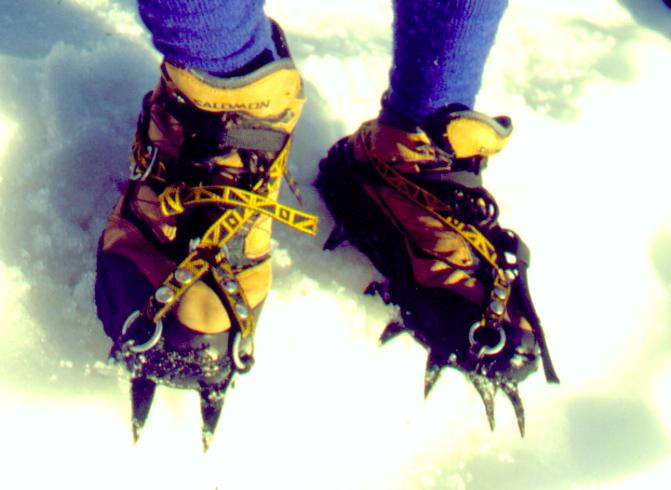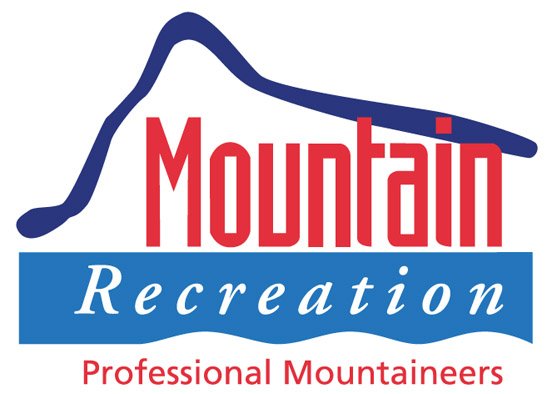mrmmr mr mr' mr mr mr mr mr rm rm mr mr mr mr mr mr mr mr mr mr mr mr mr rm mrmr mr mr mr mr mr mr mr mr mr mr mr mr mr mr mr mr mr mr mr mr mr mr mr mm |
| Upcoming Expeditions |
||||
Technical Mountain
Notes
Modifying crampon bail straps for added security.
Crampon security to the boot is a vital component to ice and snow
climbing safety and many climbers have stories of detaching crampons
from a variety of attachments.
  |
The security of "toe bail"
type crampons has has recently come to my attention following two fatal
accidents. The climbers involved happened to have "toe bail" crampon
attachments w/o an added stainless steel strap linking the toe bail to
the ankle safety strap. If the bail was to become detached then
the crampon would hang loosely on the safety strap. A steel strap adds
some stability to the attachment. I have added steel straps to some
bailed crampons along with additional diagonal straps to add stability.
The exercise was not cheap ($180) but neither is the experience of
discovering a crampon dangling from the ankle strap.
 |
 |
Snow and Ice Climbing
Time was pressing us now. We were very tired and
there was still no hint of an end. Looking down we could
see Ian using his knees. Mike rebuked him, saying that
even if he were bone-weary there was no excuse for such
bad technique when climbing. Ian looked up with a
mystified air. "Climbing? Who's climbing?" he
said. "I'm praying."
Phil Houghton NZ Alpine Journal, 1962.
Mountain climbing involves a direct
interaction with steep slopes and gravity, lifting arms
and legs and clawi ng skywards to the summit. The
descent, a downward plunge, comes as a relief, but thwart
with it's own pitfalls of fatigue and diminishing
technique. Snow and ice skills, using ice axe and
crampons, are best understood by seeing, doing and
feeling. Person al goals vary considerably, so your
learning experience, like climbing grades, should be open
ended. To become a master mountaineer requires commitment
to more than technique. Physical fitness, high
concentration, awareness of ability, fear control, and an
understanding of personal risk are all vital to be on the
inside, looking out! Accessing Routes
Heavy packs, fatigue, poor rock or snow conditions can
make access routes particularly hazardous. They are often
more dangerous than actual climbs: Loose moraine walls
are always hazardous. Snowgrass on steep slopes is very
slippery when wet. Soloing dictates caution on unstable
rock and wet snow. Access routes should be treated with
the same caution as serious climbs. The drive to and from
the road-head is no less serious.
Deep Snow Step Plugging:
When the legs plunge thigh deep into new snow and
progress grinds to a halt, consider the "double
step", amongst other grovelling options the
following: The Double Step - Step down with light
pressure until resistance is felt. Pause, then push
additional snow in from the side and apply full weight.
If the terrain is steep, an arrest axe position can be
used to distribute the load between hands and feet.
Power Step Plugging:
In a group of 3+ climbers, the leader step-plugs for a
minute or 20 paces at a faster than normal speed. They
then step one pace to the side and allow the next person
to lead before dropping to the tail-end. This allows each
person recovery time on a firm track while maintaining a
relative ly fast party travel speed. If roped in pairs,
the sequence can be modified to suit.
Self Arresting a Fall
A fall usually results from a foot slip or trip.
Self-Arresting should be practised often, but seldom
relied upon. It is an almost impossible manoeuvre to
perform on ice slopes or at speed. Mountaineers should
focus on preventing a slip with secure ice axe and
crampon technique. Accidents often happen when these
essential ice tools aren't being used.
Fall Run-outs: To reduce serious
consequences, taking route options with run-outs, rather
than cliffs or crevasses, allows a greater latitude for
error.
Arresting a Minor Slip: Climbers should practise
recovering from a stumble. A slip may be averted by
ramming a vertically held axe, sword-like into the snow,
while digging in the toe points. This is likely to be the
best opportunity to arrest a fall.
Arresting a Serious Slip: Various arrest
techniques are taught. Options should be practised.
Sequence: Try rolling into a feet downhill, flat on the
back position. Bring the axe up into a firm two handed,
across the chest, grip, then roll towards the head of the
ice-axe. Place your body in a strong triangular position
with your head and the axe pick at the apex. The feet,
wide apart, form a stable base. The body should be arched
off the snow with the feet apart and knees pressed into
the snow. Initially, keep your cramponed feet in the air
to avoid hooking. In wet snow you will need to dig them
into the snow to assist braking. Completing a self-arrest
will also ease the load on the belayer and their anchor.
Glissading
Boot sliding on sun softened snow with an erect body and
the leg support of the ice axe is called glissading. The
body is held in a flexed, erect position with hips
directly over the heels. Speed and direction control is
maintained by edging the boots. The glissade axe position
provides stability and arrest capability. On Sun softened
snow with a slope runout, controlled arcing turns can be
completed. If needed, a climber can roll into a
self-arrest without changing their handgrip.
The Ice Axe
The ice axe is the primary tool of the alpine climber. It
has four main components consisting of the pick, adze,
shaft and spike. The ice axe enables progress across
slopes with relative security. They evolved from the
large alpenstocks of 100 years ago. They are now
technical tools, used in conjunction with crampons. Most
axes have metal shafts with rubber sheath grips. The
optimum axe length is determined by the height of the
climber and inclination of climbs: The taller the
climber, the longer the axe; the steeper the climb, the
shorter the axe. Ice axe points should be kept sharp.
Sharpened adze corners are particularly useful for
cutting ice stances. A bevelled pick point & teeth
give better penetration & removal.
A general-purpose axe offers shaft and
pick support. They combine well with crampons to climb
moderately steep slopes. Most are about 70cms. long with
radius curved picks, a half set of teeth and a long shaft
spike for snow penetration.
A technical axe offers more security via
it's steeper radius or reverse curved pick and full set
of teeth. It's shorter shaft (50cms) swing combines well
with a similar ice tool on steep ice. Most technical
tools have interchangeable pick, adze & hammerhead.
North Wall Hammers add security and
hammering capacity. Most have reverse curved (positive
clearance) picks with 45cm shaft length. Curved handles
provide an easier wrist action for reaching over bulges.
They lessen knuckle damage on smooth ice, but inhibit
the vertical shaft use in snow. Most have modular picks
aiding easy replacement after breakage.
Crampons came into general use in the
1920's after a long debate over their ethics. They
improved climbing times, reduced step size and allowed a
for variety of boots. In 1938 two leading ice exponents
Vorg and Heckmair wore new 12 point crampons on the
ascent of the Nth. Face of the Eiger. H. Harrer and
Kasparek wore standard 10 point iceclaws. Step cutting
remained in use until toe points became universal on
crampons in the mid "60's. As an art, step cutting ,
the practised skill of the mountain guides, almost
disappeared. The development of curved pick ice-axes in
the late '60's complemented the toe-points. Crampons now
enable a mountaineer functional and fluid movement, with
the power and grace of a martial arts exponent.
Types: All high quality crampons are
adjustable in length. Most have 10 vertical points for
flat-footing. Longer vertical points work best in the soft
and sustrugi snows of the Southern Alps, Andes and the
Himalaya. The 2 toe (or front) points are where the most
variety lies. The toe points should protrude about 3cm in
front of the boot. Most have horizontally oriented,
curved toe points. These present more surface area and
resistance in soft snow. Most technical and waterfall ice
crampons have 1 or 2 vertical toe points for rigidity
and penetration. Broad, long heel points are also
important for New Zealand's soft snow conditions. Recent
crampon design improvements have been significant.
Attachment Systems
Ankle and toe straps have traditionally bound crampons to
boots. They continue use on soft, flexible boots. The toe
strap security is improved by a locking strap feed and
custom built toe-ankle connecting strap. Rigid crampons
with heel and toe clamps work best on stiff, new alpine
boots.
